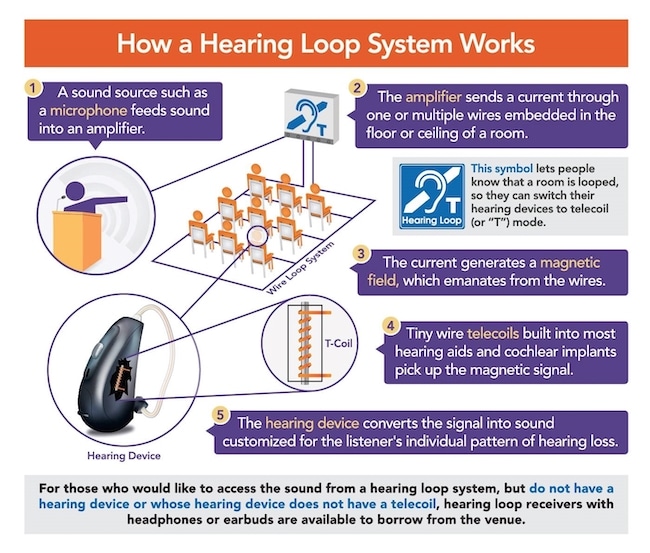Florida’s #1 Expert for Hearing Loops
The Benefits Of Hearing Loop Systems


Improve communication and expand customer engagement

Fulfil legal obligations and boost your social responsibility

Help people feel understood, included and supported

Enhance customer experience and satisfaction

Attract new customers

Encourage brand loyalty and stand out from your competitors
Schedule a Complimentary Site Visit Today!
What Are Hearing Loop Systems?
The technical name for this system is Audio Frequency Induction Loop System (AFILS), but it is also known as:
- Loop, T-Loop, Loop System, Hearing Loop System, Hearing Loop, Hearing Aid Loop
A hearing loop consists of a wire installed around or throughout a room, connected to a special hearing loop amplifier. An audio signal from a microphone, TV, PA system, or sound reinforcement system is sent to the amplifier, which drives a strong alternating current through the wire, creating a magnetic field. This field induces the telecoil (T-coil) in a hearing aid or cochlear implant.
To use the loop, a user switches their hearing aid or cochlear implant to the “T” position. The telecoil picks up the magnetic field fluctuations, converts them into alternating currents, which are then amplified and converted back into sound by the hearing instrument.

Schedule a Complimentary Site Visit Today!
Hear the Difference a Hearing Loop Can Make
Top 7 Reasons For Hearing Loop Use
Those who suffer from hearing loss require more than just increasing the volume of sound into their ears


Clarity
- Superior Clarity: Hearing loops provide greater clarity than other assistive listening systems. The hearing aid or cochlear implant, serving as the receiver, is set to the user’s specific hearing needs, unlike FM/IR systems.
- Understanding vs. Hearing: Other systems may allow users to hear sounds but not necessarily understand them. Loops enable better understanding.
Integrated Receiver
- Built-in Receiver: T-coil equipped hearing aids or implants act as receivers, eliminating the need for separate receivers and headsets.
- Consistency: Users can continue wearing their personalized hearing aids, akin to how eyeglass wearers keep their prescription glasses.
Improved Signal-To-Noise Ratio
- Better Ratio: People with hearing loss need a higher signal-to-noise ratio (15-20dB) for speech intelligibility, compared to the 6dB needed by those without hearing loss. Hearing loops deliver a clean signal directly, enhancing digital hearing aids’ effectiveness.
Noise and Reverberation Reduction
- Background Noise: The primary complaint among those with hearing loss is background noise. Activating the T-coil deactivates the hearing aid’s microphone, reducing ambient noise and reverberation.
Discreet Use
- Invisible Activation: The T-coil is activated discreetly via a button, remote control, or smartphone app, minimizing embarrassment and increasing usage.
Less Equipment Maintenance
- User-Maintained Devices: Fewer receivers and headsets are needed, reducing maintenance and hygiene issues for venues. ADA-compliant receivers are available for those without T-coil devices.
Cost Efficiency
- Cost-Effective: Although initial installation is costly, hearing loops are a better long-term investment due to higher user adoption compared to FM systems. Facilities should install loop systems even if they already have FM or infrared systems to offer users a choice.
Remember
- EVEN IF A FACILITY HAS A FM OR INFRARED SYSTEM ALREADY INSTALLED, THEY SHOULD STILL INSTALL A LOOP SYSTEM!
- People have preferences of systems to use and should have the option of choosing.
Schedule a Complimentary Site Visit Today!
Where Are Hearing Loops Used
There are two basic environments in which induction hearing loops are used: transient and extended time.
In both environments, the telecoil capability in the hearing instrument is used to listen inductively, which eliminates background noise and greatly increases speech intelligibility for the hearing instrument user.
In transient use locations it is impractical to issue and retrieve a receiver / headset due to the short or limited time of interaction or use. Unfortunately, these are often among the worst areas for problems related to speech intelligibility and background noise. These are locations like ticket windows, points of sale, bank windows, customer service desks, and pharmacies where it is one customer service agent/clerk/ticket agent communicating with one hard of hearing person. The systems used in these locations are known as ONE to ONE or 1:1.
Extended time use locations are those in which a person will be in for a longer period of time. Think house of worship, performing arts hall, meeting room, classroom, or ballroom. These are known as Area Loops or Large Area Loops. Here is it more practical to obtain a receiver but naturally the use of the hearing instrument as the receiver is preferred.
Schedule a Complimentary Site Visit Today!
How Do You Know if a Hearing Loop System is Installed?
Hearing Loop systems are used throughout the world and there is an internationally recognizable symbol that is used to indicate to the general public that a hearing loop system is installed.
The color may vary, occasionally found in green, blue, red, and yellow, but always the basic ear shape usually with something going through it like an arrow, sound wave, and etc. Anytime this symbol is present, a person with a hearing instrument can activate their T-coil or a special receiver can be used to pick up the signal.
Schedule a Complimentary Site Visit Today!
"*" indicates required fields




